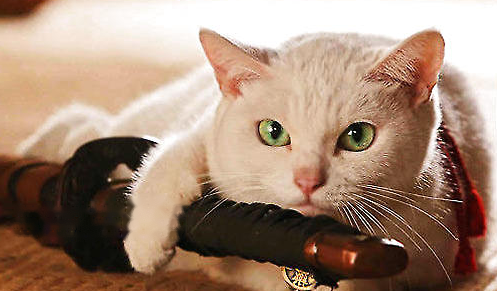Generally speaking, when the cat's body matures 2-3 months of age , you can let the cat receive the basic training. It is best to choose before feeding each training, because hungry cats are more willing and easy to get close to people. At the same time, in order to obtain food, cats will become more obedient and well-behaved, which is very effective for the training method of food temptation.

First, the basic way of training cats
1. Force
Compulsion is the use of mechanical stimuli and threatening commands to get the cat to act accordingly. For example, when training a cat to lie down, the trainer presses the cat down with his hands while issuing the lie down password, forcing the cat to lie down. After repeating this several times, the cat will soon be able to form a conditioned reflex to lie down. . When using this method with cats, control the intensity of stimulation, because cats often feel self-righteous and eat soft and not hard.
2. Induction
Induction is Refers to the use of food, objects or the actions of the trainer to induce a cat to perform a certain action. Training kittens is more appropriate to use the induction training method.
3. Rewards
The reward is to strengthen the correct action of the cat, consolidate the formed conditioned reflex or regulate the cat's neural activity state. The reward methods include food, praise and petting. Reward and coercion must be combined to be effective, and each time the cat is forced to make the right action, the reward is to be given immediately. The degree of reward should gradually escalate with the difficulty of training. It should be noted that if the reward is too frequent or the condition is too low, it is easy for the kitten to develop a mental habit of disapproving of the slight reward.
4. Punishment
Including reprimand , intimidation, beating, etc. Once you find that the cat has a bad habit, you should use punishment in time. So that the cat does not feel afraid or tired of training.
Two, let the cat develop the habit of sleeping in a fixed place
< p style=text-indent:2em>Prepare a pet litter or box for the cat before it is bought, with cotton pads or grass in it, and if it is winter, also in Put a hot water bottle or nest in a warm place and let the cat sleep in it every day.
If it is found that the cat is unwilling to go back to the den to sleep, but goes to the bed and sleeps, the owner of the cat will issue a no password and put the cat back in its own The box is covered with a barbed wire cover, and the cat is forced to sleep in it. Repeated training a few times in this way can make the cat gradually develop a good habit of sleeping in a fixed place.
Third, correct the abnormal feeding behavior of cats
Pica It belongs to an abnormal feeding behavior, mainly manifested as ingesting substances other than normal food. Such as licking, chewing wool socks, sweaters, or stealing indoor potted food when the owner is not present. Correcting pica can be done by using startle punishment to make it produce aversive conditioning, such as intimidation with mousetrap, water gun, etc. Put the mousetrap upside down (to prevent the cat from being caught) next to woolen clothing or plants. When the cat approaches, the mousetrap snaps up and makes a snapping sound to scare the cat away. When there is an abnormal feeding behavior, spray water on it immediately, and the cat will run away immediately when it is suddenly attacked. After doing this several times, the cat will be able to get rid of pica. In addition, some odorous substances that cats are more sensitive to (such as deodorant, Lysol) can also be applied to clothing or food. When cats approach these foods, they run away because of disgust.
Fourth, train cats not to scratch
For cats , jumping high, grinding claws, biting plants, etc., are normal behaviors, but after living with humans, these behaviors are interpreted as destructive behaviors, which is a bit unfair. The best solution is not to ban it blindly, but to provide appropriate alternatives to meet the needs of cats.
Take claws grinding as an example. In addition to grinding away old nails, claw marks are also a visual mark to let similar or other animals know that this is a its territory. Therefore, the owner should provide a scratching board, standing firmly on the floor, or leaning against the wall at a 45-degree angle.
Cat scratching boards can be bought in general pet stores, or you can make them yourself, just wrap them around the board with twine. Then place the scratching board near where the cat sleeps, so they want to scratch when they get up and stretch. If the number of cats is large, you must prepare a few more scratching boards, and at the same time sprinkle a small amount of the cat-scratching board on the cat-scraping board every week to maintain their interest in the cat-scraping board.
In addition, trim your cat's nails at least every two weeks. If your cat is used to grinding claws on sofas, cardboard boxes, wood, rattan chairs, or leather-covered items, you can prepare a spray gun with clean water. Whenever your cat needs to sharpen its claws on furniture other than the scratching board, spray it with a water cannon. After a few times, smart cats learn the terrible punishment for claws on furniture and switch to scratching boards. Similarly, water cannons can be used to train cats not to engage in other inappropriate behaviors.
![[Dog Training 5] The training method of pet dog dining etiquette](/static/img/12192/12192_1.jpg)




